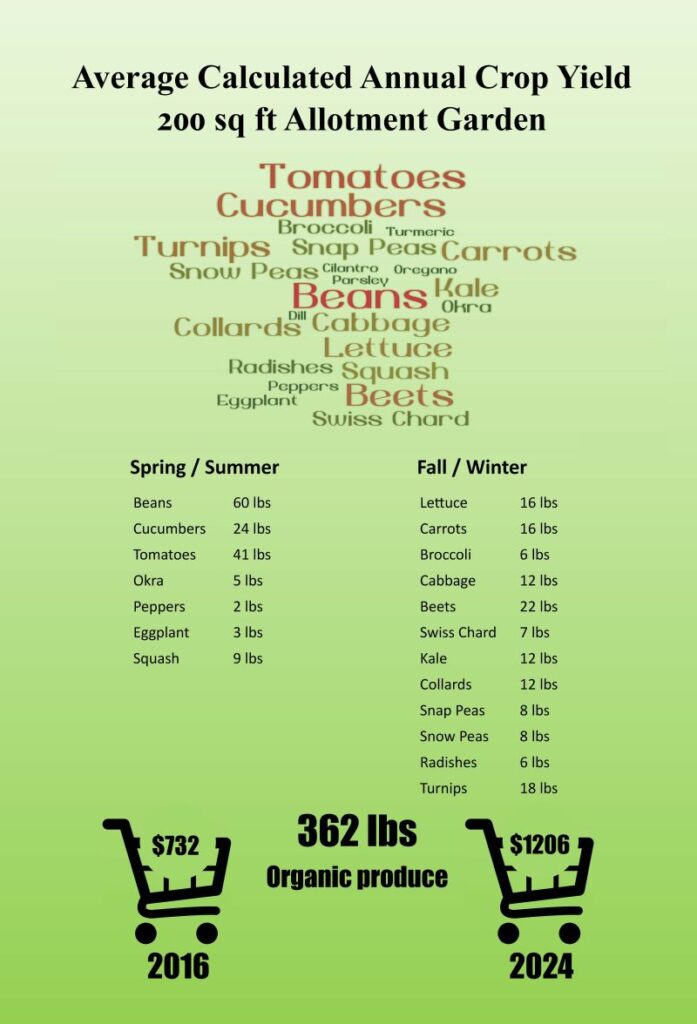Have you ever wondered actually how much produce can be grown on a 100 square foot plot? WCG raised allotment gardens are roughly 4′ x 25′ – that’s a 100 square foot plot. This study was conducted on two such plots leased by yours truly, your WCG President, and my garden partners.
THE CROPS
In 2016, I listed every vegetable that my team grew year round. That included lots of tomatoes and peppers in one bed and cucumbers, beans, squash, eggplant and okra in the other bed during the spring and summer months. Typically these plants and seeds were started in late February or March and most were finished by June, though okra and eggplant survived the intense Houston heat into July and August.
In October, we usually prepare for the cool season crops, including a bed full of brassicas and another bed full of light feeders like carrots, lettuce, Swiss chard, beets, and snap peas and snow peas on the trellis. The brassicas typically include radishes, broccoli, various cabbages, kale, and collard greens. Occasionally we add Asian greens, mustards, arugula, fennel in winter and have tried melons in summer. We grow basil in the summertime and other herbs like cilantro, parsley, dill, in the cool weather and oregano and thyme seem to thrive year round. We did not include any herbs or “occasional” veggies in this study.
Next, I looked at our planting maps and figured out the number of plants or the “row length.” In reality, we don’t plant rows, but use the square foot gardening method to maximize the production in our space. The number of plants in a 4′ x 3′ or 2′ x 3′ patch was fairly easy to calculate.
We did not weigh each and every veggie we picked during the year. Instead, the next step involves a crop yield calculator. While it may not precisely match our production, it still made for an interesting and valuable calculation. Some years we may get a bumper crop of tomatoes or cucumbers, but our summer squash production is often cut short due to the dreaded squash vine-borers. Westbury Community Garden is often asked about economic impact of the community garden in grant applications. This study gives WCG a starting place for production estimates.
The Vegetable Yield Calculator we used can be found can be found at UrbanFarmer.com.
THE RESULTS
Between the two 100 sq ft plots, the spring/summer crop pounds were estimated as:
- Beans 60 lbs
- Cucumbers 24 lbs
- Tomatoes 41 lbs
- Okra 5 lbs
- Peppers 2 lbs
- Eggplant 3 lbs
- Squash 9 lbs
Winter crops calculated at:
- Lettuce 16 lbs
- Carrots 16 lbs
- Broccoli 6 lbs
- Cabbage 12 lbs
- Beets 22 lbs
- Swiss chard 7 lbs
- Kale 12 lbs
- Collards 12 lbs
- Snap peas 8 lbs
- Snow peas 8 lbs
- Radishes 6 lbs
- Turnips 18 lbs
362 lbs of organic produce grown in two 100 sq ft plots!

THE PERSONAL ECONOMICS
The next step involved collecting the price per pound of all the different organic vegetables. Whole Foods Market was used to gather this data. In 2016, the cost of the 362 pounds of produce was $732.
In 2024, the prices were collected again. As expected, the post-pandemic inflation was reflected in the cost of groceries. The value of the 362 pounds of produce was $1206!
GARDEN WIDE ECONOMICS
We can take the 362 pounds of produce and the value of $1206, and divide them in half to get the potential economic impact of each bed – 181 pounds and $603.
With 59 cultivated plots (62 beds minus 3 herb or pollinator gardens), the numbers extrapolate to 10,679 pounds of vegetables at a value of $35,577 annually for the whole community garden!
Look how productive we can be! Keep on gardening everyone!
